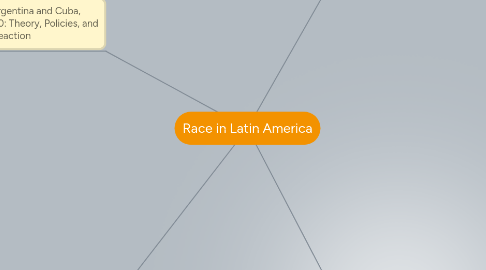
1. Race in Argentina and Cuba, 1880-1930: Theory, Policies, and Popular Reaction
1.1. At the end of the nineteenth century most of Hispanic America entered a period of economic growth.
1.1.1. Exports like massive public works, railroads, electrification of some sections of the capitals, and new factories were all changes that gave the elite the impression that it was on the way to 'modernization.'
1.2. Between 1880 and 1930, Hispanic American intellectuals were strongly influenced by positivism, social Darwinism, geographical determinism, and many racial theories emanating from Europe.
1.3. The racial issue pervaded numerous essays in Hispanic America that discussed the Indian "problem," the black "question," the consequences of "cross-breeding," or the possible emergence of a new Latin American race.
1.4. Racial Thought in Cuba: The Refusal of the African Component
1.4.1. After independence, Cuba's Creole elite, surprisingly, followed Argentina's model of nation building, despite great differences in racial makeup. The ruling class chose to reinforce the Hispanic component of the population through immigration rather than to unify the new nation.
1.5. White Policies and Black Responses in Cuba
1.5.1. As for Cuban social policy, two major concessions were made to nonwhites: the Constitution of 1901 gave them equality and universal male suffrage.
1.5.2. Many policies directly aimed at segregation blacks.
1.5.3. The Creole elite greeted the further decline of the black population to 30 percent together with the growth of the total population counted in the census of 1907 as signs of progress accompanying the rapid increase of production and trade.
2. Racial Ideas and Social Policy in Brazil, 1870-1940
2.1. The Whitening Ideal
2.1.1. After 1870 the Brazilian elite came to accept an identifiable ideology of development.
2.1.1.1. it was a form of classic liberalism
2.2. Virtually no one believed in the simple theory of biological inferiority, so abolitionists only rarely tried to refute racist doctrines.
2.3. The majority of liberal abolitionists, however, preferred to think about European immigrants as the solution to the post abolition labor problem.
2.4. Abolitionist believed that miscegenation would gradually and inexorably "whiten" and thereby "upgrade" the Brazilian view population.
2.4.1. Miscegenation, therefore, was seen as regenerative, if not biologically, at least in terms of culture contacts.
2.5. The whitening thesis got unique support in Brazil from the widespread belief, later popularized by Gilberto Freyre, that the Portuguese enjoyed an uncanny ability to whiten the darker peoples with whom they mixed.
3. Impact of the French and Haitian Revolutions
3.1. "Haitian Revolution showed blacks that liberation was a possibility in historical time." Meaning, "their condition was not an inescapable fate."
3.1.1. "The Haitian Revolution impinged in one way or another on the entire emancipation debate from the British parliamentary move in 1792 to outlaw the African sale trade to Brazil's final abolition of slavery ninety-six years later."
3.2. In the 1780's a French Colony by the name of Saint-Domingue was the center of the Atlantic slave system.
3.3. Saint-Domingue produced more than half the world's coffee, mainly with slaves and land owned by free colored people, and in 1787 exported almost as much sugar as Jamaica, Cuba, and Brazil combined.
3.3.1. Between 1791-1804 the "pearl of the Antilles" was destroyed by revolution and civil war, ignited by the French Revolution.
3.3.2. Slaves and free descendants of slaves defeated their masters and the most formidable armies of Spain, Britain, and France.
3.3.3. Douglas suggested that Haitis's freedom "was not given as a boon, but conquered as a right!"
3.4. This heroic achievement evoked little applause from whites, even those who rejoiced over the European and Latin American movements of national liberation.
3.5. The French emancipation decree of 1794 was a crucial precedent, successfully defended by the blacks of Saint-Domingue against Spanish, English, and then Napoleon's best French troops; this abolition of slavery was embodied in constitution of Haiti.
4. Racism, Revolution, and Indigenismo: Mexico, 1910-1940
4.1. Indian/Spanish polarity
4.1.1. "The Colonial regime that prevailed in Mexico for three centuries sought to preserve a degree of separation between Indian and Spaniard: careful "racial" or caste like divisions were maintained; power and privilege correlated closely with "racial" identification."
4.2. Indians are therefore socially defined, with race being used as a common but genetically unsound shorthand for ethnicity.
4.3. The blending of Spanish and Indian cultures, paralleling the blending of Spanish and Indian blood, ensured that many of the features that were later taken to be 'Indian' were in fact of European origin (just as some 'European traits were of Indian origin).
4.4. The revolution that began in 1910 could be fought and was and was fought on the basis of considerable Indian participation (more so if the broad definition of "Indian" is adopted), but in the absence of any self-consciously Indian project.
4.5. The Impact of Revolution
4.5.1. The nineteenth century saw a progressive breakdown of the caste like, colonial order and its replacement by a society stratified by class.
4.5.2. It seems probable that racism, buttressed by racial theories, became stronger in the course of the nineteenth century.
4.5.3. Powerful ideological as well as economic factors favored the development of a more virulent racism in the later nineteenth century.
4.5.4. "I would suggest, was the inherent logic of the Porfirian model of development, which required the dispossession of peasant communities (many of them Indian) and the creation of a reliable labor force, urban and rural."
4.5.4.1. Porfirian regime was one of Indian oppression
4.6. Mainstream indigenismo, advocating the progressive, persuasive integration of the Indian into Mexico society, looked to a range of policies that might advance this objective.
4.6.1. Education was the chief weapon in the indigenista armory
